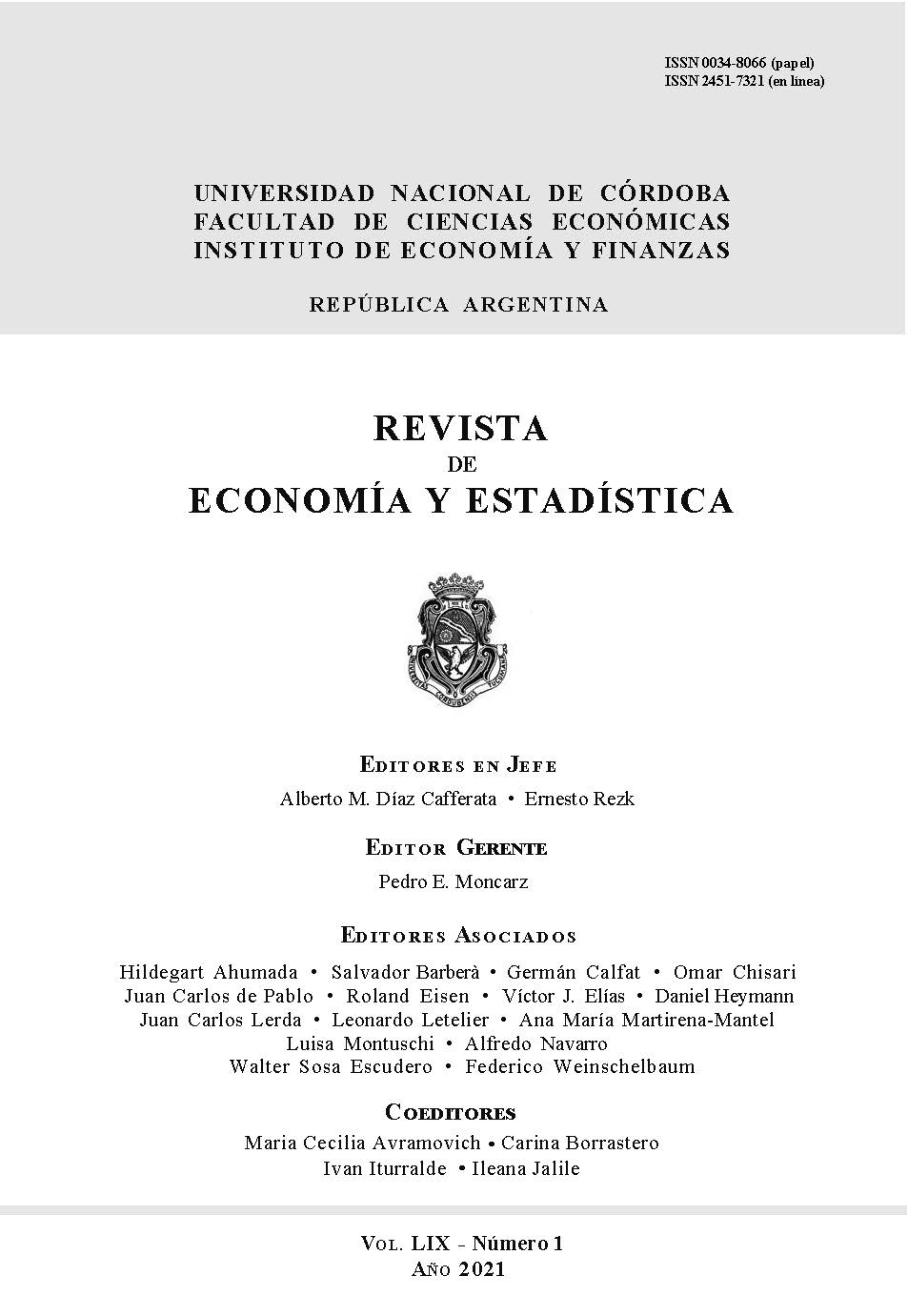Methodological considerations upon Stochastic Frontier Analysis for panel data models: evidence from cost-efficiency ECF model in the Argentine Banking Sector.
DOI:
https://doi.org/10.55444/2451.7321.2021.v59.n1.36335Keywords:
panel data, SFA, banking entities, benchmarking, simulationsAbstract
In this paper we make a methodological analysis of the Error Components Frontier (ECF) panel data model performance based on Stochastic Frontier Analysis (SFA) method for cost efficiency benchmarking in the presence of small panels and outliers. By means of a set of simulations and a subsequent application to the Argentine banking sector during the period 2005-2014, we prove that under these conditions an SFA model may not be adequate for benchmarking. These results are relevant for the empirical literature since small panels with the presence of outliers represent classical scenarios in developing economies industries.
Reception date: December 3, 2019.
Acceptance date: June 28, 2021.
Downloads
References
Aigner, D. J., Lovell, C. A. K. & Schmidt, P. (1977). Formulation and estimation of stochastic frontier production function models. Journal of Econometrics, 6(1): 21-37.
Battese, G. E. & Corra, G. S. (1977). Estimation of a production frontier model: with application to the Pastoral zone of eastern Australia. Australian Journal of Agricultural Economics, 21, 169-179.
Battese, G. E., & Coelli, T. J. (1988). Prediction of firm-level technical efficiencies with a generalized frontier production function and panel data. Journal of Econometrics, 38(3): 387-399.
Battese, G. E., & Coelli, T. J. (1992). Frontier production functions, technical efficiency and panel data: with application to paddy farmers in India. Journal of Productivity Analysis: 3(1-2): 153-169.
Battese, G. E., & Coelli, T. J. (1995). A model for technical inefficiency effects in a stochastic frontier production function for panel data. Empirical Economics, 20(2): 325-332.
Bauer, P. W., Berger, A. N., Ferrier, G. D., & Humphrey, D. B. (1998). Consistency conditions for regulatory analysis of financial institutions: a comparison of frontier efficiency methods. Journal of Economics and Business, 50(2): 85-114.
Belotti, F., Daidone, S., Ilardi, G., & Atella, V. (2013). Stochastic frontier analysis using Stata. The Stata Journal, 13(4): 719-758.
Bengston, G. (1965). Branch Banking and Economies of Scale. Journal of Finance, 20(2), 312-331.
Berger, A. & Humphrey, D. (1991). The dominance of inefficiencies over scale and product mix economies in banking. Journal of Monetary Economics, 28(1):117–148.
Berger, A. N., & Humphrey, D. B. (1997). Efficiency of financial institutions: International survey and directions for future research. European Journal of Operational Research, 98(2): 175-212.
Bogetoft, P. & Otto, L. (2010). Benchmarking with DEA, SFA, and R. Springer.
Bonin, J. P., Hasan, I., & Wachtel, P. (2005). Privatization matters: Bank efficiency in transition countries. Journal of Banking & Finance, 29(8-9), 2155-2178.
Coelli, T., Prasada Rao, D. S., O’Donnell, C. Battese, G. (2005). An introduction to efficiency and productivity analysis. Springer.
Coelli, T. & Henningsen, A. (2017). Frontier: Stochastic Frontier Analysis. R package version 1.1-2. https://CRAN.R-Project.org/package=frontier.
Cornwell, C., Schmidt, P., & Sickles, R. C. (1990). Production frontiers with cross-sectional and time-series variation in efficiency levels. Journal of Econometrics, 46(1-2): 185-200.
Ferrara, G. & Vidoli, F. (2017). Semiparametric stochastic frontier models: A generalized additive model approach. European Journal of Operational Research, 258(2): 761-777.
Ferro, G., León, S., Romero, C., & Wilson, D. (2013). Eficiencia del sistema bancario argentino (2005–2011), Anales XLVIII Reunión Anual de la Asociación Argentina de Economía Política. Rosario, Argentina: Universidad Nacional de Rosario.
Greene, W. (2005a). Reconsidering heterogeneity in panel data estimators of the stochastic frontier model. Journal of Econometrics, 126(2): 269-303.
Greene, W. (2005b). Fixed and random effects in stochastic frontier models. Journal of Productivity Analysis, 23(1): 7-32.
Han, C., Orea, L., & Schmidt, P. (2005). Estimation of a panel data model with parametric temporal variation in individual effects. Journal of Econometrics, 126(2): 241-267.
Henningsen, A. & Kumbhakar, S. (2009). Semiparametric stochastic frontier analysis: An application to Polish farms during transition. In European Workshop on Efficiency and Productivity Analysis (EWEPA) in Pisa, Italy, June (Vol. 24).
Henningsen, A. (2018). Introduction to Econometric Production Analysis with R (second edition). Collection of Lecture Notes. Department of Food and Resource Economics, University of Copenhagen.
Isik, I., & Hassan, M. K. (2002). Cost and profit efficiency of the Turkish banking industry: An empirical investigation. Financial Review, 37(2), 257-279.
Jondrow, J., Lovell, C. K., Materov, I. S., & Schmidt, P. (1982). On the estimation of technical inefficiency in the stochastic frontier production function model. Journal of Econometrics, 19(2-3): 233-238.
Kumbhakar, S. C. (1990). Production frontiers, panel data, and time-varying technical inefficiency. Journal of Econometrics, 46(1-2): 201-211.
Kumbhakar, S. C., Park, B. U., Simar, L., & Tsionas, E. G. (2007). Nonparametric stochastic frontiers: a local maximum likelihood approach. Journal of Econometrics, 137(1): 1-27.
Kumbhakar, S. C., Lien, G., & Hardaker, J. B. (2014). Technical efficiency in competing panel data models: a study of Norwegian grain farming. Journal of Productivity Analysis, 41(2): 321-337.
Lee, Y. H., & Schmidt, P. (1993). A production frontier model with flexible temporal variation in technical efficiency. En The Measurement of Productive Efficiency: Techniques and Applications. H. O. Fried, C. A. Knox Lovell, and S. S. Schmidt (eds.), 237–255. New York: Oxford University Press.
Lovell, C. A. K. (2003). The decomposition of Malmquist productivity indexes. Journal of Productivity Analysis, 20(3): 437-458.
Meeusen, W. & van den Broeck, J. (1977). Efficiency estimation from Cobb-Douglas production function with composed error. International Economic Review, 18: 435-444.
Pitt, M. M., & Lee, L. F. (1981). The measurement and sources of technical inefficiency in the Indonesian weaving industry. Journal of Development Economics, 9(1): 43-64.
Schmidt, P. & Lovell, C. A. K. (1979). Estimating technical and allocative inefficiency relative to stochastic production and cost functions, Journal of Econometrics, 9(3): 343-366.
Schmidt, P., & Sickles, R. C. (1984). Production frontiers and panel data. Journal of Business & Economic Statistics, 2(4): 367-374.
Sealey, C. & Lindley, J. T. (1977). Inputs, Outputs and a Theory of Production and Cost at Depositary Financial Institutions. Journal of Finance, 32(4), 1251-1266.
Surroca, J., Prior, D. & Tribo Gine, J. A. (2016). Using panel data DEA to measure CEOs' focus of attention: An application to the study of cognitive group membership and performance. Strategic Management Journal, 37(2): 370-388.
Vidoli, F. & Ferrara, G. (2015). Analyzing Italian citrus sector by semi-nonparametric frontier efficiency models. Empirical Economics, 49(2): 641-658.
Weill, L. (2004). Measuring cost efficiency in European banking: A comparison of frontier techniques. Journal of Productivity Analysis, 21(2), 133-152.
Williams, J. (2012). Efficiency and market power in Latin American banking. Journal of Financial Stability, 8(4), 263-276.
Downloads
Published
Issue
Section
License

This work is licensed under a Creative Commons Attribution-NonCommercial-NoDerivatives 4.0 International License.
Authors who have publications with this journal agree to the following terms:
Authors retain their copyright and grant the journal the right of first publication of their work, which is simultaneously subject to the Creative Commons Attribution-NonCommercial-NoDerivatives 4.0 International License that allows third parties to share the work provided that its author and first publication in this journal are indicated.
Authors may adopt other non-exclusive licensing arrangements for distribution of the published version of the work (e.g. depositing it in an institutional telematic archive or publishing it in a monographic volume) as long as the initial publication in this journal is indicated.
Authors are allowed and encouraged to disseminate their work via the Internet (e.g. in institutional telematic archives or on their website) before and during the submission process, which can lead to interesting exchanges and increase citations of the published work. (See The Open Access Effect)














